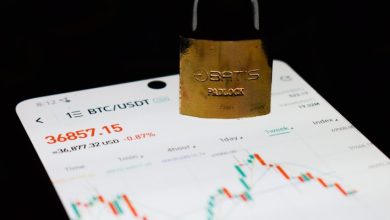How to Set Realistic Risk Tolerance Levels for Crypto Investing

- Understanding risk tolerance in crypto investing
- Factors to consider when setting risk tolerance levels
- Balancing risk and reward in your crypto investment strategy
- Tips for assessing your personal risk tolerance
- Why realistic risk tolerance levels are crucial in crypto investing
- Strategies for adjusting your risk tolerance as market conditions change
Understanding risk tolerance in crypto investing
When it comes to investing in cryptocurrencies, understanding your risk tolerance is crucial. Risk tolerance refers to the level of uncertainty or volatility you are willing to handle when investing in crypto assets. It is essential to assess your risk tolerance before diving into the cryptocurrency market to avoid making impulsive decisions that could lead to significant financial losses.
Assessing your risk tolerance involves evaluating your financial goals, investment timeframe, and overall comfort level with market fluctuations. Some investors may be comfortable with taking on high levels of risk in pursuit of higher returns, while others may prefer a more conservative approach to minimize potential losses.
It is important to remember that the cryptocurrency market is highly volatile and can experience extreme price fluctuations in a short period. Therefore, it is crucial to align your risk tolerance with your investment goals to create a balanced portfolio that suits your individual needs and preferences.
Factors to consider when setting risk tolerance levels
When it comes to establishing risk tolerance levels for crypto investing, there are several important factors that need to be taken into consideration. It is crucial to carefully assess these factors in order to set realistic risk tolerance levels that align with your investment goals and financial situation.
One key factor to consider is your investment timeline. Depending on whether you are looking for short-term gains or long-term growth, your risk tolerance levels may vary. Short-term investors may be more willing to take on higher levels of risk in exchange for the potential for quick profits, while long-term investors may prefer a more conservative approach to minimize potential losses.
Another factor to consider is your financial situation. It is important to assess your current financial stability, income, expenses, and overall net worth before determining your risk tolerance levels. Investing more than you can afford to lose can lead to financial hardship and stress, so it is essential to set realistic risk tolerance levels based on your financial situation.
Additionally, your knowledge and experience in the crypto market should also play a role in determining your risk tolerance levels. If you are new to crypto investing, you may want to start with lower levels of risk until you gain a better understanding of the market dynamics and potential risks involved. On the other hand, experienced investors may be more comfortable taking on higher levels of risk based on their knowledge and expertise.
Overall, setting realistic risk tolerance levels for crypto investing requires a careful evaluation of your investment timeline, financial situation, and knowledge of the market. By considering these factors thoughtfully, you can establish risk tolerance levels that are appropriate for your individual circumstances and investment goals.
Balancing risk and reward in your crypto investment strategy
When it comes to crypto investing, finding the right balance between risk and reward is crucial. One way to achieve this is by diversifying your portfolio. By spreading your investment across different cryptocurrencies, you can reduce the overall risk of your portfolio. It’s important to consider the volatility of each cryptocurrency and how they may behave under different market conditions.
Another strategy to manage risk is to set stop-loss orders for each investment. This allows you to automatically sell a cryptocurrency once it reaches a certain price point, limiting your potential losses. It’s also essential to stay informed about the latest market trends and news that could impact your investments.
On the other hand, it’s essential to assess the potential rewards of each investment carefully. High rewards often come with high risk, so it’s crucial to weigh the potential gains against the potential losses. Consider factors such as the technology behind the cryptocurrency, its market cap, and its growth potential when evaluating the reward of an investment.
Tips for assessing your personal risk tolerance
Assessing your personal risk tolerance is a crucial step in setting realistic levels for crypto investing. Understanding how much risk you are comfortable with can help you make more informed decisions and avoid unnecessary stress. Here are some tips to help you evaluate your risk tolerance:
- Consider your financial goals and time horizon: Think about what you want to achieve with your investments and how long you have to reach those goals. This can help you determine how much risk you are willing to take on.
- Evaluate your past investment experiences: Reflect on how you have reacted to market fluctuations in the past. Have you been able to stay calm during periods of volatility, or do you tend to panic and make impulsive decisions?
- Assess your overall financial situation: Take into account factors such as your income, expenses, and other investments. Knowing your complete financial picture can give you a better sense of how much risk you can afford to take.
- Understand different types of risk: There are various types of risk associated with investing in cryptocurrencies, including market risk, regulatory risk, and technological risk. Educate yourself about these risks and consider how comfortable you are with each of them.
By taking the time to assess your personal risk tolerance, you can set realistic levels for crypto investing that align with your goals and financial situation. Remember that risk tolerance can change over time, so it’s important to regularly reassess your comfort level and adjust your investment strategy accordingly.
Why realistic risk tolerance levels are crucial in crypto investing
Realistic risk tolerance levels play a crucial role in crypto investing. It is essential to understand that the cryptocurrency market is highly volatile and unpredictable. Setting realistic risk tolerance levels can help investors manage their expectations and make more informed decisions.
By determining your risk tolerance, you can establish how much risk you are willing to take on before investing in cryptocurrencies. This will help you avoid making rash decisions based on emotions or market hype. It is important to assess your financial situation, investment goals, and risk appetite before diving into the world of crypto.
Having realistic risk tolerance levels can also prevent you from investing more than you can afford to lose. Cryptocurrency investments come with a high level of risk, and it is crucial to only invest money that you are willing to part with. Setting realistic risk tolerance levels can protect you from financial ruin in case of market downturns.
Furthermore, understanding your risk tolerance can help you stay calm and composed during turbulent market conditions. It can prevent you from panic selling or making impulsive decisions that can lead to losses. By setting realistic risk tolerance levels, you can approach crypto investing with a clear mind and a long-term perspective.
Strategies for adjusting your risk tolerance as market conditions change
It is crucial to adjust your risk tolerance as market conditions change in the world of crypto investing. Here are some strategies to help you navigate through these fluctuations:
- Stay Informed: Keep yourself updated on the latest news and trends in the crypto market. This will help you make informed decisions and adjust your risk tolerance accordingly.
- Diversify Your Portfolio: Spread your investments across different cryptocurrencies to reduce risk. Diversification can help mitigate losses during market downturns.
- Set Stop-Loss Orders: Consider setting stop-loss orders to automatically sell your assets if they reach a certain price. This can help you limit your losses and protect your investments.
- Reassess Your Goals: Regularly reassess your financial goals and risk tolerance. Your goals may change over time, and it is essential to adjust your risk tolerance accordingly.
- Consult with a Financial Advisor: If you are unsure about how to adjust your risk tolerance, consider consulting with a financial advisor. They can provide personalized guidance based on your financial situation and goals.
By following these strategies, you can effectively adjust your risk tolerance to align with changing market conditions in the crypto industry. Remember that risk tolerance is a personal decision and should be based on your financial goals and comfort level with volatility.



